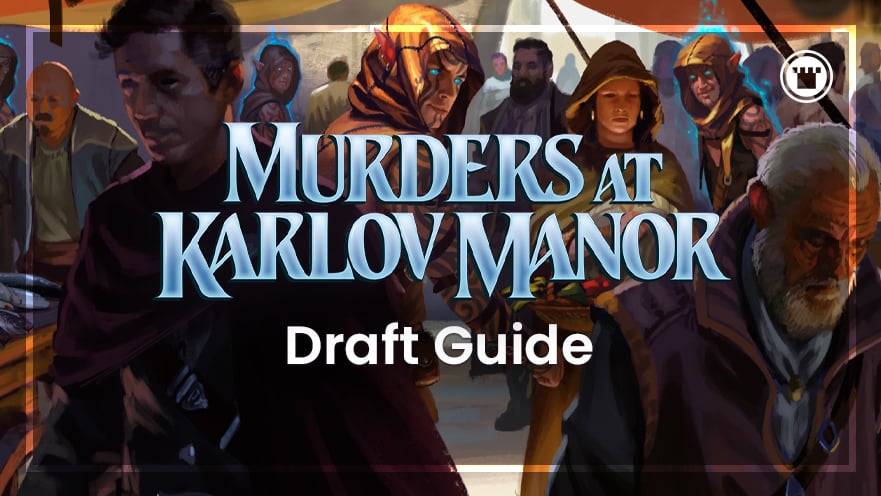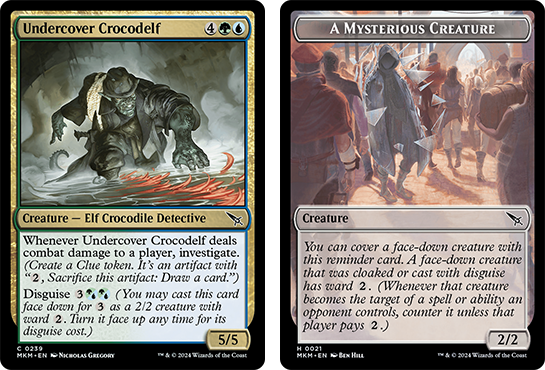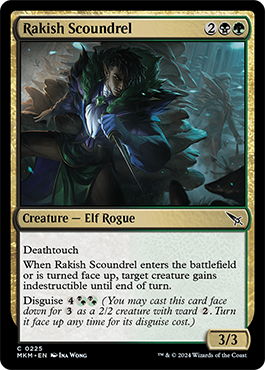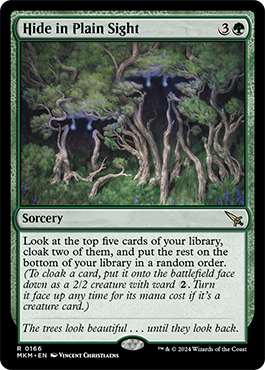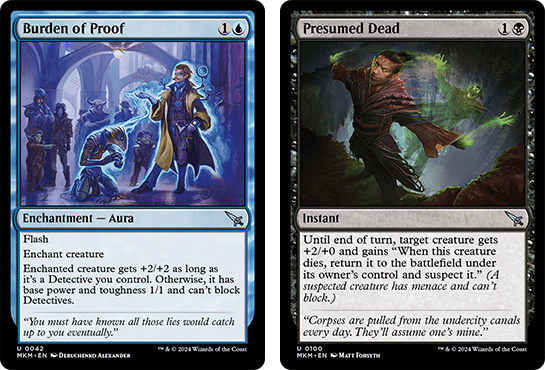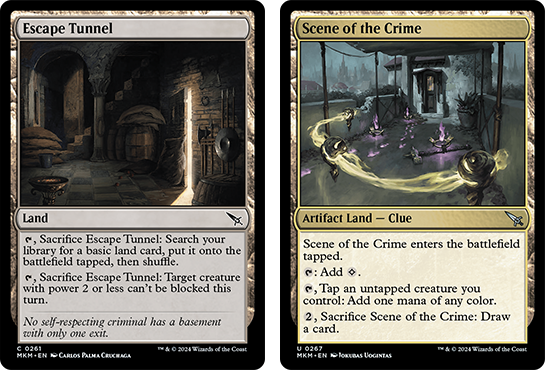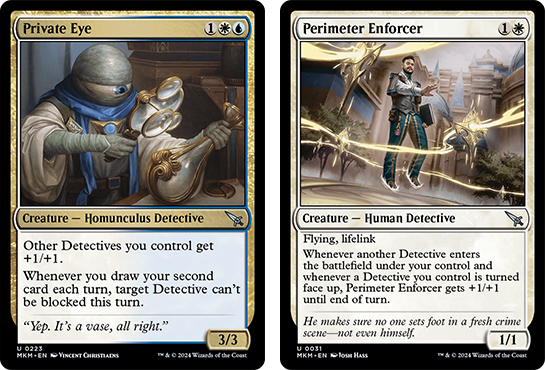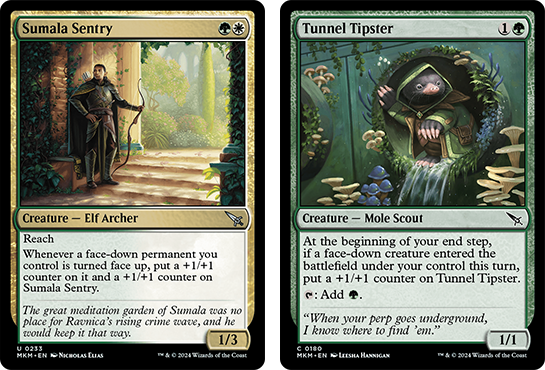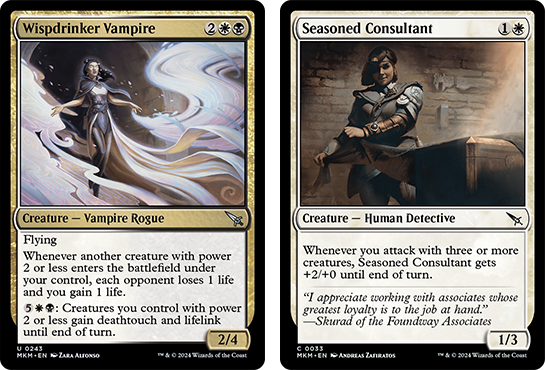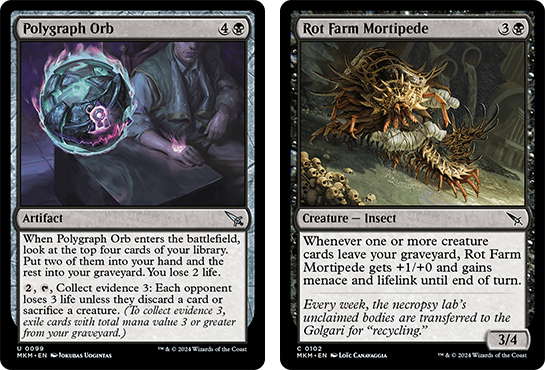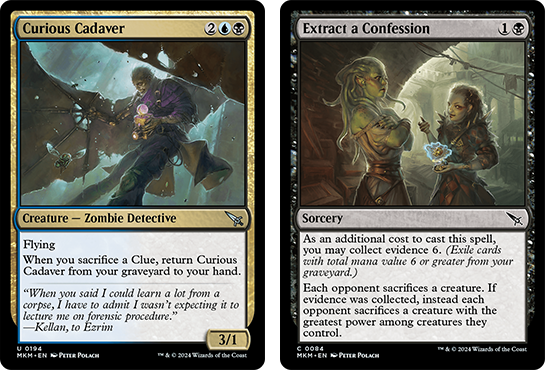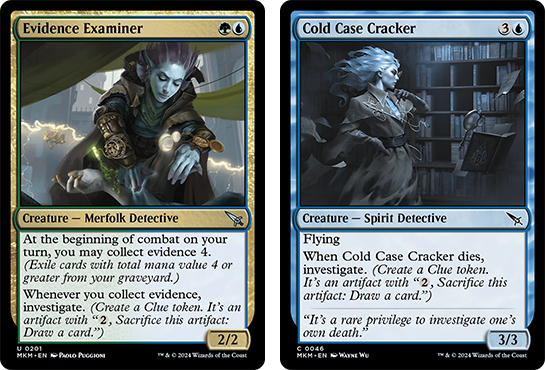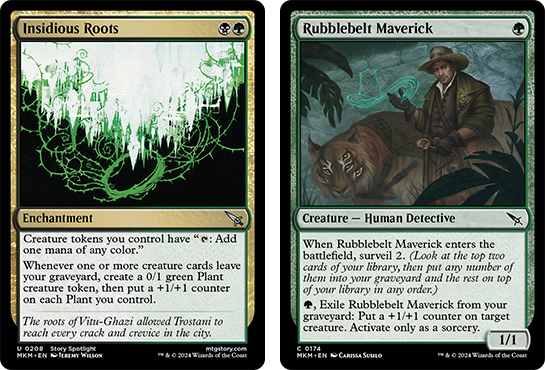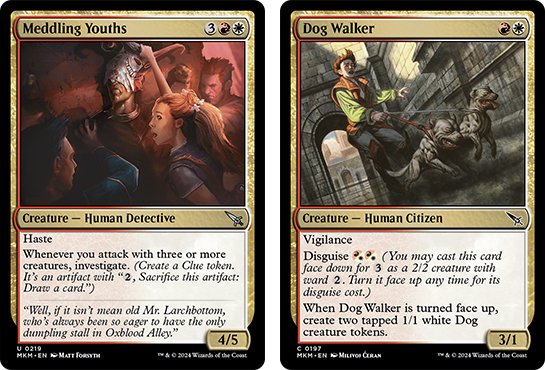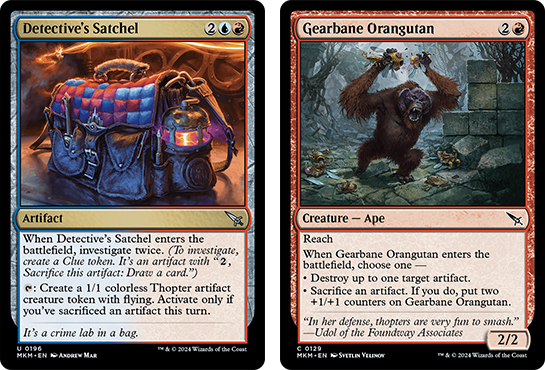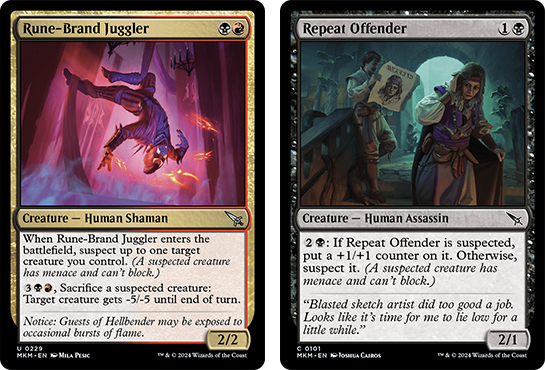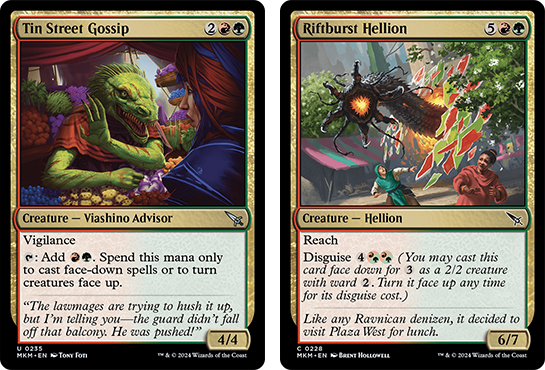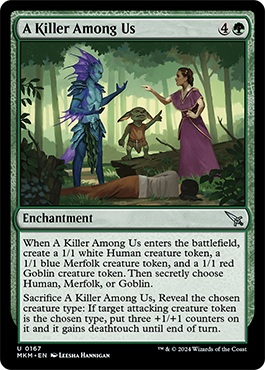Ah, it feels good to be back in Ravnica again for a new set. Murders at Karlov Manor combines the hybrid color creativity we’re used to with all sorts of detective-story antics, and even a bit of crime noir borrowed from New Capenna. That Capennan influence is also felt in the draft format, with many mechanics that complicate blocking and make aggressive, tempo-controlling decks very powerful.
It may sound like a tricky case to crack, and the weirdness of face-down creatures will certainly take some getting used to for those who haven’t dealt with it before. But follow the leads I’ve laid out for you, and you’ll have this case solved in no time!
THE SHAPE OF THE FORMAT
Obviously every draft format is a unique experience, but some are more unique than others. Murders at Karlov Manor does more to mess with your “default” expectations for Limited than any set since The Brothers’ War.
The entire environment is warped around the Disguise mechanic, which allows you to play a creature face-down by paying 3 generic mana instead of the normal casting cost (which is often much higher). Face-down creatures are anonymous to your opponent, as they all cost the same amount and all count as being 2/2s, with no types or abilities except Ward 2.
These face-down creatures can then be turned face-up at any time by paying a set cost which is unique to each Disguise creature. And I mean any time – turning creatures face-up like this doesn’t even go on the stack, meaning your opponent cannot Shock your 2/2 after you pay to flip it into something bigger. However, any abilities the creature may trigger when it turns face-up will go on the stack and can then be responded to as normal.
Disguise shows up at common across every color, so expect it to feature at some point in almost every game of Murders at Karlov Manor Limited. Much less common is Cloak – a mechanic which lets certain spells put other cards into play as face-down “mysterious creatures”. Because Cloak is often putting these cards into play from private zones like your hand or library, it is possible to cloak any card as a 2/2 creature – lands, instants and sorceries included. These non-creature cards cannot be turned face-up while on the battlefield, but they serve as valuable decoys and blockers. Cloaked creature cards can be turned face up for their normal casting cost, or their flip-up cost if they already had Disguise naturally.
So right off the bat, we know that nearly every Murders at Karlov Manor deck will feature a lot of 2/2s with Ward 2 for 3, which really changes how you have to evaluate removal spells, combat tricks, and other buffs. Speaking of combat tricks, Disguise itself acts like a trick when choosing attacks and blocks. Choosing to flip up one of your 2/2s into a 7/6 after blocks are locked in can dramatically punish an opponent who isn’t ready to respond in kind.
When you consider that the actual tricks in this set are also strong, and removal – especially instantly speed – is weaker and more scarce than usual, you can understand how important it is to have more mana available whenever you seek to force trades in combat. Often that means a lot of mana, since many of the flip-up costs in Murders at Karlov Manor are high enough to take up your whole turn, so there is also a lot of advantage in having a life lead when going for this sort of attack – otherwise your opponent can “force” a flip up by blocking and leave you with an expensive tapped creature and no mana to defend yourself from the return attack.
So, for multiple reasons we have a set where players struggle to attack with confidence, and if they do it’s often with 2/2s. This means any strategy which can present consistent aggression with less mana available has gamebreaking potential. Flyers stand out as especially potent, as there are only two cheap reach creatures at common and neither inherently has more than 2 power – a 3/3 for four mana like Cold Case Cracker can be a significant threat.
In fact, creature stats are generally lower than expected, perhaps to balance better around the mob of 2/2s. Tunnel Tipster and Reckless Detective are great examples of how anything cheap which provides a better rate – even if it needs a little help – can help you seize the initiative early in a match. Let your opponent be the one having to make tough decisions around flip-up mana and risky blocks – the smartest sleuths love an easy job.
HOW MANY COLORS TO PLAY?
Murders at Karlov Manor is trying something new compared to previous Ravnica sets, but there’s no chance we’d have a set on the city-plane without a strong multi-color element. I would describe the fixing as “adequate”, with multiple any-color lands, the excellent Escape Tunnel at common, and Case of the Shattered Pact as a tease towards playing rainbow decks. The new Surveil lands might not be the most exciting rares to open, but with all 10 in the same set they show up fairly often and can really help enable a splash color.
The set draws you into drafting three or more colors in a lot of situations anyway. A high number of the playables are multicolor, and the mechanical synergies across color pairs like UG, GB and UB are very strong. Disguise cards are instrumental in bridging the gap here. You can always play them face-down for generic mana if you’re struggling to find the right lands, and the multi-color ones can be flipped up for more forgiving hybrid mana costs. This is often crucial for filling out a strong creature curve if you didn’t have an open lane from the start of the draft – fitting Gadget Technician and Crowd-Control Warden into your RW deck feels very much intended by the designers (especially if you’re trying to solve the Case of the Shattered Pact on the side).
I’d say that drafting a clean two-color deck is still what you’re hoping for at the start of Pack 1. But as we go over the identity of each two-color archetype, keep in mind where the ones with colors in common seem to overlap. That way you’ll be able to comfortably shift into three or more colors to accommodate your best spells and still have a coherent gameplan.
WU: Detective Tempo
In a set where creatures are generally weaker, the free stats generated by a typal synergy deck are gamebreaking. Even if you don’t have those buffs online early, you can start attacking with solid two drops like Marketwatch Phantom, Perimeter Enforcer and Seasoned Consultant, when your opponent is probably also tapping out to play early drops and thus cannot easily risk blocking against open mana.
Once you’ve built a life lead, UW has a lot of options for how to close things out. You have an unfair number of flyers to easily win the race as your opponents struggle to get through your chump blockers. Playing from in front means you can save Makeshift Binding or Dramatic Accusation to clear any anti-air blockers which may appear. Crimestopper Sprite, Private Eye and Exit Specialist are among your best cards because they offer the same utility stapled to a Detective! So long as you’re patient and pick your spot, the UW deck always finds a way to get its man.
WG: Good Creatures (And Some Removal)
White and green don’t seem to have a single shared identity in Murders at Karlov Manor. Instead, we have a handful of very distinct “packages” within WG, each of which will potentially lead you to draft a very different looking deck.
The easiest to explain is Detectives: green is the only color which can really replace blue if you’re trying to take advantage of the strong white typal cards like Perimeter Enforcer and Case of the Pilfered Proof. GW gets fewer flyers than UW, but better stats and more removal. Then there’s the Disguise package. Multiple Tunnel Tipsters are the best way to start this off, with Sumala Sentry, Neighborhood Guardian and Haazda Vigilante bringing further face-down synergy.
These are also arguably the best starting colors to stretch into a five-color deck, thanks to fixing from Buried in the Garden plus the general color flexibility you gain when building around Disguise. Case File Auditor can significantly increase your odds of digging up Case of the Shattered Pact, and can also find most of your removal spells and Airtight Alibi for interaction. If you’re not quite that ambitious, just try to grab up the hybrid cards from neighbouring pairs to up your disguise count – Dog Walker in particular really enables Greenbelt Radical and Crowd-Control Warden.
WB: Go Wide Aggro
WB doesn’t offer us any one keyword or creature type to lock onto, but that doesn’t mean it’s in the same position as WG. Looking closely, it’s clear what these colors have in common – lots of small aggressive bodies, backed up by just enough removal and synergies to help them get under larger opposition. We just need to find ways to be dealing damage every turn – whether that’s removal for blockers, deathtouch, flying, Suspect (both on their creatures and ours), or direct damage in the late game.
That last method is the most reliable, so keep an eye out for Lead Pipe, Alley Assailant, Soul Enervation, Polygraph Orb and Wispdrinker Vampire as cards which might push you towards these colors. If you can find enough of them to rely on every game, you can afford to play a bit more conservatively, perhaps drafting more defensive cards like Rot Farm Mortipede and Sanctuary Wall.
Considering that a lot of other decks are also trying to start off quick and put you on the defensive, this could end up being the most consistent way to draft WB as the metagame of the set matures. It’s unfortunate that white really doesn’t offer anything that can leverage the self-mill and collect evidence subthemes in black. The real trick is to mix in green as well – then the rough edges of all three colors can really snap together into a cohesive, grindy deck that attacks opponents early and drains them out late.
UB: Clue Control
The power balance between threats and answers doesn’t make it easy to play control in this set, but UB definitely has some powerful tools to make up the difference. The presence of clues means you can get the card advantage you need without needing to give slots over to cards which don’t impact the board, so prioritize drafting as many solid creatures and removal spells as you can.
Anything which lines up well against disguised creatures is important, for obvious reasons. Reasonable Doubt is… reasonable, but far less potent here than in the aggressive decks where suspecting creatures is helpful. Better to rely on the uncounterable Slice from the Shadows and Long Goodbye, or combat tricks like Eliminate the Impossible and Behind the Mask. Presumed Dead won’t stop your creatures trading with theirs, but it can lead to huge value by bringing your disguised blocker back into play face-up, or recurring ETBs like Hotshot Investigators and Undercity Eliminator.
Once you have a stable defense, the naturally slower pace of the set can work in your favour. Unscrupulous Agent and Cerebral Confiscation will reliably hit in this format, thanks to extra Clue draws and opponents investing mana in flip-up costs rather than playing out their hands. Curious Cadaver, Agency Coroner and Magnifying Glass can help you win the card-advantage war in the other direction. After that, finish them off with black’s direct damage, big flyers, or maybe something spicy in Persuasive Interrogators or Living Conundrum.
UG: Clues and Evidence
UW may have the most Detective creatures, but it’s actually UG which seems to be doing the hard work of investigating crime in Ravnica! Clue tokens are a great way to ensure you can keep spending mana effectively as the game goes on, while collect evidence adds an immediate bonus to your spells for no extra mana. Combining the two means UG has both short-term and long-term value covered, and only UR can really claim to match its overall efficiency.
In order to access that value, we need to both prolong the game and load up our graveyard with evidence to collect. We could wait for that to happen naturally over time, but getting the extra kick from collecting evidence on early turns really helps us to keep up with aggro decks, so it’s worth finding ways to enable it. Flotsam//Jetsam and Topiary Panther generate 6+ mana of available evidence at the cost of just two, and are especially good if you’re already holding up that mana for Reasonable Doubt and Unauthorized Exit. Candlestick is also a highly-efficient way to mill yourself if you have the chance to attack a few times early on.
Value-generating triggered abilities are the final piece that unlocks UG’s potential in longer games. Evidence Examiner, Surveillance Monitor and Chalk Outline are the most valuable – but you can almost double your possible hits if you dip into black as well. A three-color deck is easily supported through green’s fixing, and the extra synergy from cards like Insidious Roots and Persuasive Interrogators is extremely powerful.
GB: Self-Mill Midrange
Since I’ve already mentioned that black cards are the secret sauce for improving WG and UG decks, it shouldn’t be too surprising that I think GB as a color pair is also pretty powerful.
Collect evidence is very forgiving as a central mechanic; the cards which help you mill extra evidence into the yard tend to be good spells in their own right, so you don’t need to worry about getting stuck with a bunch of enablers and no payoffs. The evidence payoffs tend to be playable without collecting evidence, and excellent with it, so no real worries there either. All you really need to do is try and work in extra ways to get high-cost cards into the graveyard – but you can do that just by having disguised creatures die or by casting the cheap side of split cards.
There’s no one standout gameplan here once you have the graveyard engine running, but you should be able to rely on green’s big bodies and both colors’ excellent removal to dominate the board state. That said, I do need to specifically point out Insidious Roots as maybe the best uncommon in the set – both it and Chalk Outline can easily take over a game with how often a GB deck can trigger them and how slow the rest of the set plays.
WR: Aggro Soup
Like WG, WR is an archetype trying to make do with a mix of not-very-synergistic card packages. Unlike WG, those cards all at least push you towards one style of deck: full-on aggro. Since being the beatdown is so good in Murders at Karlov Manor (and, spoilers, my early read is that red is the best color in this format), it’s worth a little bit of potential awkwardness to make WR cards play nice together.
If you’re drafting these colors from a white-heavy start, you’re probably eying up ways to enable white’s Detective theme. Red only has three creatures with that type, all at uncommon – and Reckless Detective in particular will be hotly contested as the best two-drop in the set. But we also have Person of Interest and Felonious Rage at common, which can efficiently generate Detective tokens to up your count. If you start out more heavily in red, you can also build around the artifact-sacrifice themes, giving you another way to utilise white’s Clues.
Neither of those themes will be as consistent in this deck as they are in other color pairs, so it’s important to focus more on playing a strong, aggressive curve and taking advantage of combat tricks, burn and buffs to wreck attempts at blocking. This set has some impressive equipment and auras to help your 2/2s beat their 2/2s, and “battalion” creatures like Seasoned Consultant will be the glue that can hold the disparate parts of your deck together.
UR: Artifact Sacrifice
This is the format’s strongest synergy deck, with more even distribution of power through its cards than UW and a higher ceiling than anything but the best Insidious Roots decks. Your core pieces are cards with “when you sacrifice an artifact” or similar triggered abilities. Reckless Detective is a mythic uncommon; get it down early and you can simply ride it to victory by holding up burn spells, Reasonable Doubt and The Chase is On to crush multi-blocks. Thopter tokens are a genuine threat in Murders at Karlov Manor and will help you finish a lot of games.
Detective’s Satchel, Crime Novelist and Gleaming Geardrake are slightly more dependent on actually making other artifacts, but something like Harried Dronesmith or Curious Inquiry on a flyer can make that trivial. You can raise the value even higher by using Gearbane Orangutan (the set’s only good reach blocker) or Cornered Crook as your sacrifice outlet!
How you play around those engines really depends on what interaction and support cards you have. If you have auras, equipment, and combat tricks, you can play fast – give Fae Flight and/or Convenient Target to your attackers and then bounce, burn or suspect their blockers so you can crash on through. If you have burn spells, Detective’s Satchel and the Sudden Setback/Dramatic Accusation combo, you can play control. The hardest part is simply drafting those chase uncommons in the first place.
BR: Suspect Tempo
RB’s gameplan in most recent Limited sets is about trying to rapidly force a lot of card-for-card trades, which limits how many creatures are in play for either side. A small board state makes finding good blocks harder, and empowers RB’s signature mechanics like menace or Act of Treason effects. Suspecting creatures is also perfect for those situations, so that’s what RB is trying to play around in Murders at Karlov Manor Draft.
My only issue with that premise is that there seems to be far fewer ways of suspecting than a solid draft archetype would want. Only one single card – Convenient Target – is capable of making more than one creature suspect without help, and that’s assuming you can kill or sacrifice the previous target to free up the aura. I can understand why Wizards would be cautious about letting you repeatedly suspect opposing blockers, but why is it so hard to suspect your own stuff- especially if we’re expected to utilize cards like Agency Coroner.
As such, I wouldn’t get too invested in trying to make suspect synergies work. It’s perfectly fine for giving things menace and reducing your opponent’s available blockers. You do definitely need to be the aggressor for it to work at all, so prioritize everything mana-efficient and then let black’s discard spells even up the hand size for you.
RG: Disguise Zoo
The term “Zoo” itself might be a bit archaic at this point, but it feels very fitting for this archetype. Not only is RG playing a beatdown strategy with a high creature count and even mana curve, it’s also leveraging a flexible manabase to cast a menagerie of the strongest possible threats regardless of color. As I said in the RW section, the disguise mechanic seems intended to help support an open-ended approach to color, and this archetype really needs to leverage that to keep up with UR, UW and UG.
Another way of understanding this is that RG has very cheap, efficient removal, large expensive creatures, and ramp/fixing spells. The interaction can stop opponents from snowballing out of control early, while you focus on stabilizing and slamming body after body. Face-down disguise creatures have felt like a liability at times more than a strength, but they are at least a way for your expensive bombs to have impact in an early-game situation. And if you make it far enough to start flipping Crowd-Control Warden, Vengeful Creeper and Riftburst Hellion face-up, that can very rapidly swing the combats in your favor.
Despite the mechanical incentives, I would caution against drafting too many disguise creatures unless you have multiple Tunnel Tipsters drafted. The flip-up costs for most of them are expensive, and you really cannot afford to block with them if your opponent is representing a trick/flip-up and you aren’t. That’s why it’s best for such creatures to occupy just the top of your curve, with Rubblebelt Maverick, Pompous Gadabout and Gearbane Orangutan below them to make a more immediate impact.
THE MYSTERY IS AFOOT
Murders at Karlov Manor is a very complicated set to try and draft for the first time. Not just in terms of how much rules text is on every card – I think most invested Magic players have just gotten used to that by now! But even when thinking about how different cards and color combinations can fit together, things are not so straightforward here as in most Limited environments.
You need to prioritize taking solid playables, since every pack has fewer cards and there’s plenty of niche and non-playable chaff. That often means being ready to pivot or splash into different colors, and picking up fixing to ensure you can consistently cast what you’ve picked. But then there’s plenty of color combinations where only half the cards in each color can really be used to their full extent, due to the different overlaps in key mechanics!
That’s a ton to try and juggle on top of tricky gameplay mechanics like disguise and collect evidence. That’s why even the most famous investigators use help – and I hope that through this guide, I can play the valuable sidekick to your Murders at Karlov Manor adventures!

Tom’s fate was sealed in 7th grade when his friend lent him a pile of commons to play Magic. He quickly picked up Boros and Orzhov decks in Ravnica block and has remained a staunch white magician ever since. A fan of all Constructed formats, he enjoys studying the history of the tournament meta. He specializes in midrange decks, especially Death & Taxes and Martyr Proc. One day, he swears he will win an MCQ with Evershrike. Ask him how at @AWanderingBard, or watch him stream Magic at twitch.tv/TheWanderingBard.

